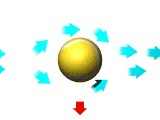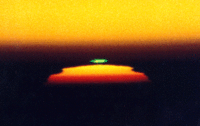

Anyone watching Federer and Agassi battle it out saw ‘top spin’ at work on the ball.
Here’s why it happens.
Now for the tennis ball. It doesn't look much like a wing. You can tilt the wing (change its angle of attack) and it looks different. Ignoring the seams, regardless of how you "tilt" the tennis ball it still looks the same - you can't change the angle of attack on a spherical ball.
So, how do you generate lift on a ball? Let's review what we said about generating lift on a wing: lift is generated by creating a pressure difference and deflecting the flow. To create a pressure difference on the wing we need to move more fluid around one side than the other - we need to set up the imbalance. Spinning the ball will do this.
When an object like a ball rotates, the fluid (liquid or gas like air) that is in contact with the balls surface tends to rotate with the ball. The air (a little bit farther from the ball) next to the air on the surface tends to do the same thing and so on. Far from the ball this rotation does not affect the surrounding air. But very close to the ball these fluid layers make up what is called a "boundary layer".
Let's look at topspin - the offense stroke in tennis. If the ball wasn't rotating as it flew through the air then both the top and bottom sides of the ball would meet the air rushing over it at the same speed.
But the ball is spinning. Relative to the ball, in topspin the top of the ball spins forward (top to bottom) into the oncoming air. There is more movement of the air towards the bottom surface. Now, more fluid needs to pass through the same space on the underside of the ball. (Basically, the flow is squashed on the lower side of the ball.) This means there needs to be a higher velocity on the lower side of the ball, and subsequently a lower velocity on the top of the ball.
On the top side of the ball this lower velocity creates a higher pressure and at the bottom the higher velocity creates a lower pressure. (This is an application of Bernoulli's Law.) With high pressure on one side and low pressure on the other there is an imbalance in the forces on the ball. In the case of top spin the higher pressure on the top curves the ball downward from its straight line path.
This effect is called the Magnus effect. It affects all sports balls (the hook and slice in golf, the infamous curveball in baseball) and ballistics.
Topspin pulls the ball down faster - its lift is in the negative direction.
What about flat (no spin) balls? There's no spin so there's no lift! That's right - a flat ball only has 2 forces acting on it - drag and weight.









